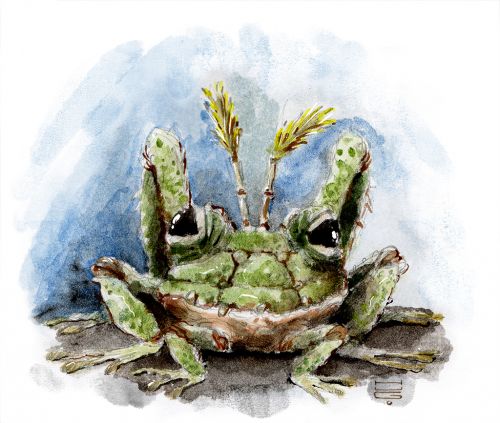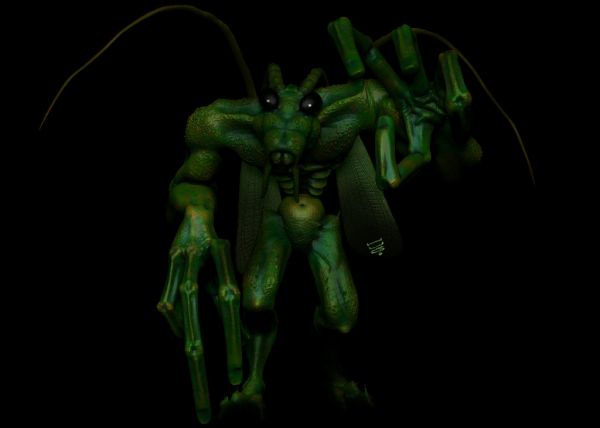Difference between revisions of "Mantodeia"
ScruffyHugo (talk | contribs) (Created page with "=Montodeia & Great Toads= ==Great Toads== A Residuum species surviving from ancient times, their adaptability and persistence allowed them to withstand the insatia...") |
ScruffyHugo (talk | contribs) |
||
| Line 1: | Line 1: | ||
| + | [[File:2022_03_28_Lume_GreatToad_Preview.jpg|thumb|500px|border|right|Being [[Fauna|Cryptids]], some Great Toads exhibit signs of continued mutation. This particular example boasts an additional set of forelegs, and the usually warty skin has hardened in places to form plates. The presence of antennae is a curious feature, perhaps accounting for the loss of sensitivity to the skin? Then again, mutations don't have to make sense.]] | ||
| + | |||
=Montodeia & Great Toads= | =Montodeia & Great Toads= | ||
| Line 12: | Line 14: | ||
The ''Mantodeia'' are long-lived, and for many [[Time|Cycles]] exist as small nymphs, growing each time they molt their exoskeleton. Believed to be Folk-sized in maturity, it is unknown if this is the limit of their growth. They are diurnal, possessing compound eyes with excellent stereo vision, as well as vocal chords, thanks to the genetic sorcery of the [[Deumana]]. The ''Mantodeia'' are known to be very capable at speaking in [[Tongues]]. They exhibit a rocking motion when postulating - much like some creatures will pace - a throwback to their Dictyoptera fore-bearers. The males are wingless, and smaller than the significantly more rapacious females of the species, which may prey on the former. Though the ''Mantodeia'' feed on some amphibians species, they are preyed upon by others, like the ''Great Toads''. The characters ''Cephalus'' and ''Toadie'' are irregular in this sense, though unlikely relationships are not that uncommon on Lume. The story of their meeting would be a good tale to hear. | The ''Mantodeia'' are long-lived, and for many [[Time|Cycles]] exist as small nymphs, growing each time they molt their exoskeleton. Believed to be Folk-sized in maturity, it is unknown if this is the limit of their growth. They are diurnal, possessing compound eyes with excellent stereo vision, as well as vocal chords, thanks to the genetic sorcery of the [[Deumana]]. The ''Mantodeia'' are known to be very capable at speaking in [[Tongues]]. They exhibit a rocking motion when postulating - much like some creatures will pace - a throwback to their Dictyoptera fore-bearers. The males are wingless, and smaller than the significantly more rapacious females of the species, which may prey on the former. Though the ''Mantodeia'' feed on some amphibians species, they are preyed upon by others, like the ''Great Toads''. The characters ''Cephalus'' and ''Toadie'' are irregular in this sense, though unlikely relationships are not that uncommon on Lume. The story of their meeting would be a good tale to hear. | ||
| + | |||
| + | [[File:Lume_khan_preview.jpg|thumb|600px|border|center|A sculpted likeness of Khan, the infamous ''Mantodeia'' who roamed the forests to the west, preying on academics and hopeful diplomats wishing to engage with the [[Druids]] there. This long-lived specimen would pose the following riddle, "What house does one leave wiser than they were upon entering?", which should have been obvious to any scholar. Ironically, Khan met his end at the hands of impatient [[Faux Giants]], who were presumably too hungry for puzzles.]] | ||
==Cephalus & Toadie== | ==Cephalus & Toadie== | ||
Latest revision as of 12:14, 28 March 2022

Montodeia & Great Toads
Great Toads
A Residuum species surviving from ancient times, their adaptability and persistence allowed them to withstand the insatiably experimental techno-gods. These large amphibians exhibit limited sentience, and can be reasoned with, though their hunger ultimately drives them. They are larger than Folk, and easily a match for any warrior. Toads have a thick, leathery hide, being near impervious to burning, cuts, or bludgeoning. Their bulk is carried on large, rear legs, that allow for awesome leaps, and their fore-legs are capable of dexterous manipulation; they can sit on their haunches, freeing their hands for fine tasks. A long tongue ending in a sticky, bulging mass, is their chief weapon, as well as their primary weakness, for a creature may strike at this fleshy appendage when caught. Prey can also hurt the amphibian from the inside, as the Toads swallow prey whole. To prevent this, older, wiser Toads will jump on their prey prior to swallowing. They are generally solitary creatures, fighting each other for the right to a mate, or for territory. There are several recorded cases of them cohabiting with Folk villagers, or other species, for mutual gain.
Mantodeia
A profound Cryptid, these mantis-like insects were created by the old gods, Deumana, to serve them as philosophical sparring partners, as well as tutors for their offspring, back in the era when the self-made deities still possessed the ability to reproduce. It's believed these techno-gods were motivated by proto-Lumian beliefs, which held that the insects were both wise, and lucky. Despite their monstrous pride, the god-like Deumana may have realised the drawbacks of ever-present sycophants, and sought after company that could, if not rival their intellect, at least maintain a worthwhile conversation.
Despite their acumen, the Mantodeia did not join the Allied Races in their fight for emancipation, nor banded to form their own society afterwards. Rather, they shunned the trappings of court and technology - ridding themselves of the gilded and intricate robes forced on them by the ancient Deumana - and opting for an existence as ascetics. While most of them avoid other Races - preferring their own company - some of their number have turned cruel in their intellect, for they are carnivores, and predatory. Like the fabled pre-proto-Lumian Sphinx, when these insects encounter prospective prey, they may engage them in a philosophical discussion, or pose a riddle or problem. This is done not out of sportsmanship, but as a way to gauge the difficulty the prey may offer them in its capture - more a sense of self preservation than of honour - as intelligent prey is oftentimes dangerous. If the quarry responds confidently, and with skill, the Mantodeia is likely to pass them by, perhaps even providing a lesson or reward, if they feel so inclined. Should, however, the victim squirm and stutter, the insectoid hermit wastes no time in taking them apart with their raptorial forelegs and sharp pincers. Why the old gods opted to equip such weaponry on essentially philosophic creatures is anyone's guess, though it is this writer's belief that the Deumana were not without a sense of irony.
The Mantodeia are long-lived, and for many Cycles exist as small nymphs, growing each time they molt their exoskeleton. Believed to be Folk-sized in maturity, it is unknown if this is the limit of their growth. They are diurnal, possessing compound eyes with excellent stereo vision, as well as vocal chords, thanks to the genetic sorcery of the Deumana. The Mantodeia are known to be very capable at speaking in Tongues. They exhibit a rocking motion when postulating - much like some creatures will pace - a throwback to their Dictyoptera fore-bearers. The males are wingless, and smaller than the significantly more rapacious females of the species, which may prey on the former. Though the Mantodeia feed on some amphibians species, they are preyed upon by others, like the Great Toads. The characters Cephalus and Toadie are irregular in this sense, though unlikely relationships are not that uncommon on Lume. The story of their meeting would be a good tale to hear.

Cephalus & Toadie
Cephalus, the brains behind the insect and Toad duo, and co-proprietor of Cephalus' Rarities & Antiqueables, is either an ambitous, juvenile Mantodeia, or one whose growth has been suspended at the nymph stage of development. Standing at a one-and-one-half hand-spans, it may be he is a related species, or a new mutation. Cephalus claims to take his name from a famously successful merchant from proto-Lumian philosophy, and aspires to greatness himself, though his ambitions far outshine his abilities. He and Toadie operate a dingy, used bric-a-brac store in the swamps of the Inland Forests, a location he is convinced will be the center of an important trade route - once the cartographers find it and drain the swamp, of course. Their merchandise is typically rusty, worn out, rotting, moldy junk, though there are in fact some authentic items of interest in their collection, and perhaps even a couple of Relics. Because of this, they have retained a small, loyal clientele that provide the dubious duo with the patronage needed to maintain their remote existence; namely Toadie's appetite, and Cephalus' penchant for tomes, scrolls, and fine wine. Since becoming acquainted with Fern, they have come to increasingly rely on her Pack to obtain their vendibles, leaving the duo more time to run their store, and dream big dreams.
How the two met is yet to be learned, though it's notable that Toadie has attained a rather discerning palate ... for a toad. Cephalus himself has fostered cooking into a form of self-defence, fashioning dishes to stave off hungry, potential mates long enough to escape their attention. Due to the oftentimes cannibalistic traits of the species' females, Cephalus has opted for a bachelor's life, which may have affected his growth. Fern is almost sure Toadie is female, and it's likely the two enjoy a platonic relationship. Tell-tale signs are Toadie's pond-bed, bedecked with flowers, the hat collection nearby, and a discernibly clean kitchen.
